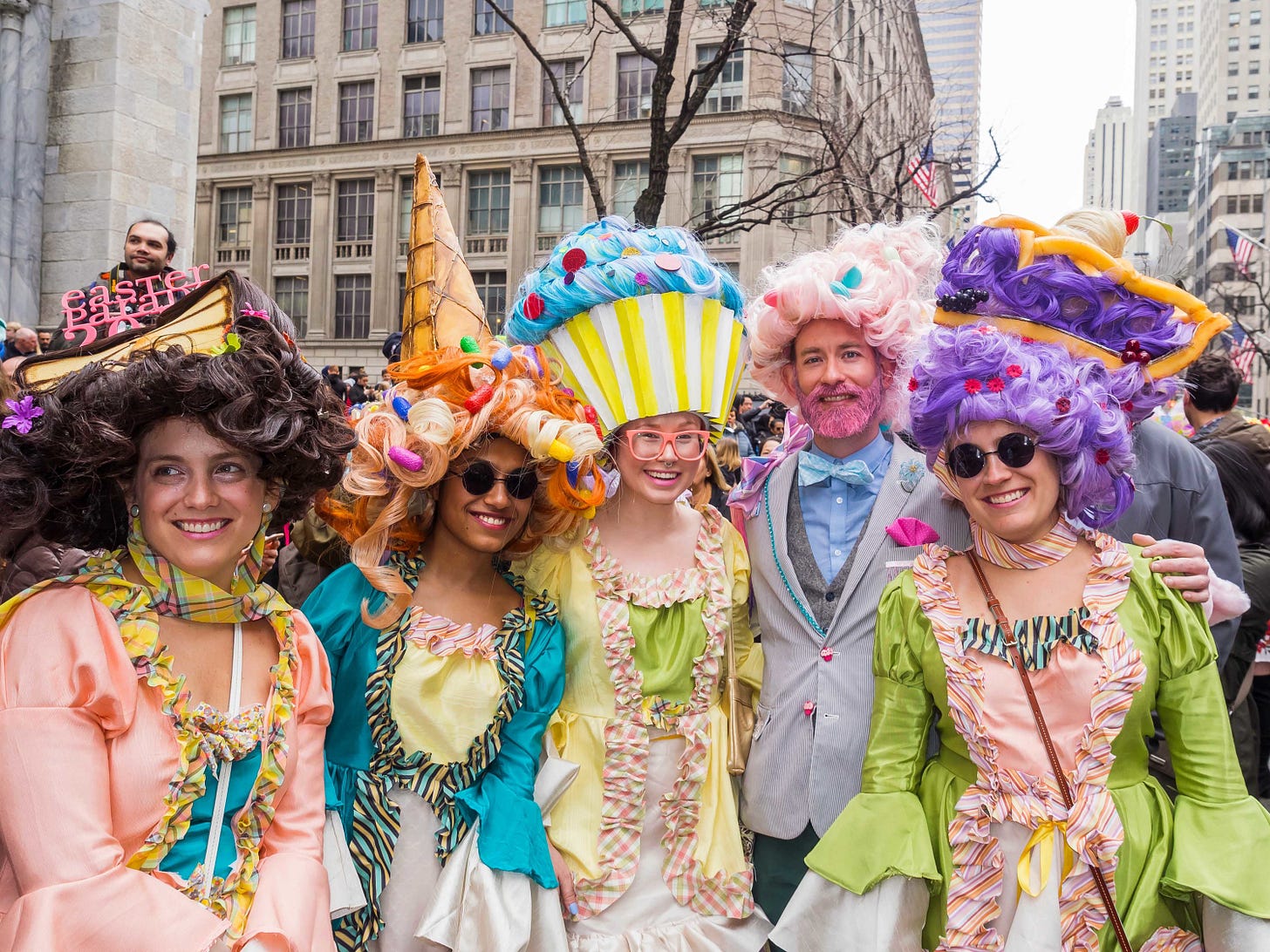Unraveling Easter: Lesser known facts from the Encyclopedia of Easter, Carnival, and Lent
Discovering the Hidden Gems of Easter
As a (fairly crucial) part of a clergy family, Holy Week feels like being the ambitious clown with the spinning plates. It doesn’t help that I have a child with a birthday that almost always falls within or near Holy Week. (Really, that one’s on me). But a huge chunk of my job is to keep traditions going—palm processions, certain music pieces, filled Easter baskets, particular foods, an abundance of colored eggs. (We also celebrate Pesach with our Jewish family, so you can throw in Haggadahs, plastic jumpy frogs, and matzah.)

But how much do we know about Easter, its origins, and the myriad ways it's celebrated around the globe and throughout history? Lately, I’ve been reading through Tanya Gulevich's formidable work, "Encyclopedia of Easter, Carnival, and Lent," and I’ve compiled a list of things that I find interesting.
Colin’s heard enough of them, time to drop them on you!
And so, with gratitude to Tanya Gulevich for her comprehensive research, let's explore the lesser-known facets of Easter and Holy Week. Here are some things I didn’t know about Easter:
If you've ever graced a recorder with the tune “Hot Cross Buns”, then you've just performed an old English advertising jingle. The song was sung outside of bakeries to sell these delicacies on Good Friday. Sweet, often with raisins and spices, the hot buns marked with a cross were believed to be immune to mold and decay, to heal you of stomach illness, and people hung them in their houses as protection from illness, lightning, fire, and misfortune.
Along with bird symbols like the peaceful dove and the pelican (yes, the pelican), the fiery phoenix was often adopted as a symbol of the resurrection and often used to decorate the urns of early Christians. Jewish folklore said that the Phoenix was the only creature that did not eat the forbidden fruit in the Garden of Eden and thus retained its eternal life. Pomegranates, too, had a connection to rebirth and resurrection through the Persephone’s myth and was taken over by early Christians making connections between their new beliefs and their Greek and Roman culture. In early art and later stained glass, Jesus was often depicted as a child giving his mother a pomegranate, or symbolized by seeds bursting forth from the split rind of a pomegranate just as Jesus bursts from the tomb.
In the late medieval ages, European folks would pay clergymen in eggs. In France, Italy, and Hungary, they performed a “Veneration of the Cross” on Good Friday where baskets of eggs were left by the cross.
Pope Gregory the Great wanted to emphasize the somberness of the Lenten season and declared the word Alleluia off-limits for seven weeks (3 weeks prior to Lent through Easter.) This led to the custom of “burying the Alleluia” where a scroll with the word Alleluia was walked out of the sanctuary, occasionally in a coffin, and buried or hidden until Easter day. The Eastern Orthodox, North African, and Middle Eastern churches didn’t like the Pope and purposely kept the Alleluia in the season to spite him. Love a good spiteful Alleluia!
In many churches, palm fronds are often saved from the previous Palm Sunday to burn for this year’s Ash Wednesday ashes. FYI, burning palm fronds absolutely smell like weed and the practice has gotten many a pastor a visit from the local police.
Easter Sunday used to be the day when baptisms were performed. In the early church, almost all folks interested in baptism were adult catechumens (cat-uh-KYOO-mens) who had undergone 2+ years of formal education and training in Christianity. This practice gave way to infant baptisms, likely to allay fears in a world where infant mortality was common. Emperor Justinian passed a law in the sixth century that infant baptism was mandatory, and Easter Baptism fell out of practice officially.
German Folklore has April Fools’ day as the birth of Judas and as the day Satan fell from Heaven.
Carnevale, or the pre-Lenten celebration of feasting and parties, is a way to celebrate before people abstain from meat for the weeks of Lent. While our earliest documents call the practice “carnelevare” meaning “to lift meat,” there are many arguments that point to the simplicity of the Latin words: “Carne” and “Vale,” which means “Meat Farewell.”
Photo by Ugur Arpaci on Unsplash Easter Dates: Determining a date for Easter was a nightmare for the early church. As the practice of selecting a date for remembrance of the resurrection grew more of interest to the church, people argued over everything. Different calendars abounded. Some churches just married it to Pesach (Passover) celebrations, some did the Sunday following Pesach, and others wanted it uncoupled from the Jewish calendar and picked their own date. The Council of Nicaea and Emperor Constantine tried to remedy this by declaring that all Christians should celebrate it on a Sunday following the spring equinox. The only problem was that the church didn’t know when the spring equinox was. East and West Equinoxes were different. The Celtic church ignored them both because they hadn’t been invited to the Nicaean council. For the Celts, it took until the 7th century and a Celtic king celebrating a different Easter than his Roman Catholic Queen for the two churches to figure out a shared date.
We see remnants of this today:
The Western Church celebrates Easter as follows: It must be on the Sunday that follows the first full moon after the spring equinox. You’ll notice that we just had equinox, and a full moon, so this Sunday is Easter. Our Easter typically falls between March 22-April 25.
The Eastern Orthodox Church celebrates Easter on a Sunday, after Passover, following the equinox which they observe on a different day. Their Easter typically falls between April 4 - May 8. There have been calls for us to get it together, literally, but we haven’t been able to come to common ground.
Easter Parades were an occasion for people to wear new clothes out and about, highlighting the trend of wearing new clothes on Easter. Manufacturers encouraged the practice because of the clothing and hat sales accompanying the holiday. The largest of these happened in NYC, starting at St. Patrick’s Cathedral. Naysayers complained about the fashion takeover, citing vanity, materialism, competitiveness, and the surge in demand that worsened sweatshop conditions and child labor. Protestors turned up to New York’s parade in ragged clothes with signs stating "One Fifth Avenue gown equals a year of relief.”
In 1952, advertisers and promoters had gotten out of hand, as designers set up platforms in front of St. Patrick’s to parade their clothes and hats, celebrities tried to get attention for their projects, and manufacturers paid people to parade with ads. Clergy successfully pressured network televisions to reduce coverage of the parade, and police were out in force the next year against advertisers. As attention died down and more informal wear took over in church attendance, the practice morphed from a fashion parade to a sillier costume event called the Easter Parade and Bonnet Festival that still exists today.
The oldest reference to the Easter Hare is from a German book printed in 1572. The "egg-bearing hare" came to America with German immigrants, particularly the Pennsylvania Dutch. When it gained popularity in the USA and morphed into an Easter Bunny, the idea and accompanying celebrations traveled back to Europe and influenced European celebrations.
Mexico City's Iztapalapa Passion Play started in 1833 to express gratitude to Jesus for stopping a cholera epidemic. The passion play lasts several days and covers two and a half miles, and some families have ancestral rights to play certain roles like Jesus, The Blessed Virgin Mary, and the Disciples as they retain documents assigning the roles to their ancestors. There are character requirements of the actors, such as being of good reputation and for Jesus, having the ability to carry a 45 lbs cross for 2 1/2 miles. Alongside the actors, people dress in purple robes and crowns of thorns and walk with Jesus in bare feet to fulfill vows made during the year.
Bells were a common feature of European life, announcing the time, prayer services, and even deaths. Deaths were announced by rings corresponding to a person’s gender (nine times for a man, six for a woman, three for a child) followed by rings corresponding to the person’s age. On Good Friday, nine bells are rung for Jesus, then 33 for his age. Bells were often muffled or had wooden clackers installed during Lent, and when the bells returned at Easter, they were credited with bringing the Easter eggs with them.
The Easter Witch - Swedish and Finnish schoolgirls would make a costume from their mothers’ clothing and apply rouge for rosy cheeks. They offered the households they visited an Easter Letter, recited a good luck poem, or carried a willow switch to switch people for good luck. Similar to Halloween, households offered coins and candy to the witches. In other areas, people believed that witches were especially active on Holy Week, and so folks would carry their brooms and billy goats with them to prevent them from being stolen by an errant witch needing transportation.
Lastly, did you know that Easter was not commonly celebrated in the United States? Because America was largely Protestant, folks retained suspicions of holidays that had their roots in Catholicism while others objected to a festival that could be considered of pagan origin. Resistance occurred largely in “low or plain church” denominations like Baptists, Quakers, and Methodists. It was after the Civil War that most churches warmed up to the holidays after a period of Easter merchandising, and secular celebrations like the Easter parade, the Easter Bunny, and Easter cards rose to prominence.
As a history buff, I find things like this fascinating.
As a human, I think it is crucial to remember that the way we do things today is not always how it was done.
Remember when Netflix came in the mail?
Traditions often have this strange quality. They serve the purpose of community closeness, celebration, memory storage, nostalgia, knowledge transmission, and more. However, they sometimes change to better reach a changing culture. I think it’s important to evaluate traditions we may have left behind to ensure we aren’t losing something. I think it’s equally important to evaluate traditions to ensure they are accessible and positive for our current community.
If you’d like to learn more about Easter, Carnival, and Lent, I highly recommend Tayna Gulevich’s book. She has 790 pages, I could only highlight 16 entries!
Learn More:
Gulevich, Tanya. Encyclopedia of Easter, Carnival, and Lent. Detroit: Omnigraphics, 2002. It can be accessed via the Internet Archive here.
(Now a message from our sponsor: Hi, it's me, Shay, author of above. Just a quick message that I am a budding Church historian in grad school with a mission to bring academic subjects into wider conversation. If you'd like to support my work and ongoing journey, I would love it if you would subscribe. If you find my work helpful, you can upgrade to a paid subscription through Substack to help buy me a book or two for class, or tip me at the paypal button below. Thanks!)






